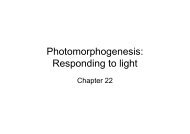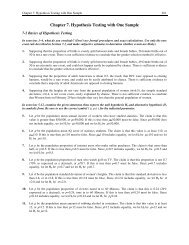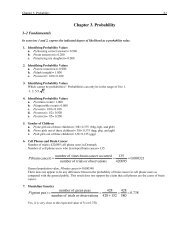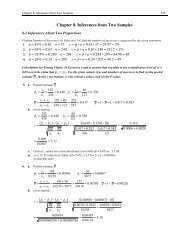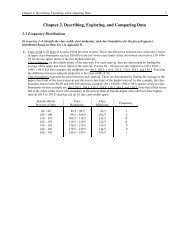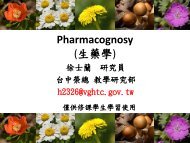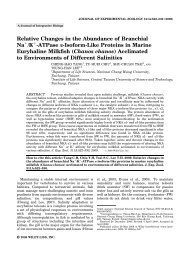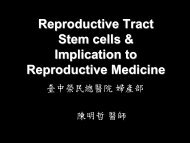transgene
transgene
transgene
- No tags were found...
Create successful ePaper yourself
Turn your PDF publications into a flip-book with our unique Google optimized e-Paper software.
History of transgenic animal production*1970's, first transgenic mice via viralinfection, but not germline transmission*1980's, first transgenic mice viamicroinjection, the most popular technique*1985, first transgenic mice harboring hGH gene;transgenic rabbits and sheep had beendeveloped*1990’s, commercial transgenic services, viatransgenic facility*1995's, transgenic farm animal companiesas bioreactors and organ donors Target Gene –“Transgene”P*Promoter/enhancer - when, where,how much• * Coding sequence - coding the• specific protein• * Ploy-A-tail signal - mRNA stability2
Gene Transfer Methods Direct microinjection Virus mediated gene transfer Embryonic stem cells Nuclear transfers Artificial chromosomes forgene transferVirus particle packaging andtarget cell infectionI. Recombinant virus particleproduced in packaging cellsIII. Target cell infections ofrecombinant virus particleII. Harvested and Concentratedrecombinant virus particles3
Virus mediated genetransfer (II)* direct transfection of embryos has resultednon-germline transgenics* ES cells transfection has resulted ingermline transgenics* has succeeded in chicken, fish and monkey* only small <strong>transgene</strong> construct is usable(
Establishing Transgenic Mice withRetroviral Vectors Direct Microinjection (I)* inject DNA molecules (<strong>transgene</strong>s)directly into male pronucleus* most popular technology, commercialavailable* the success rates range from 10-30%depending on skills and constructs* the efficiency is not related to thecopies of <strong>transgene</strong>s injected5
Direct Microinjection (II)* the technique can be applied to otherspecies* no theoretical limit for the size of theconstruct* overall efficiency is still low, particularlyfor farm animals* tandem repeat of gene constructs(head-tail)* initial investment is high, a minimum ofUS$100K to startPreparing to MicroinjectAn one-cell stage embryo is ready to be injected andthe 2 distinct pronuclei can be clearly obtained. TheDNA will be microinjected into one or, if possible, bothpro-nuclei.6
Microinjection ManipulationAn 1-cell 1stage embryo is being microinjectedinto the larger (male) of the two pro-nuclei.Establishing Transgenic Mice withDNA Microinjection7
Embryonic Stem Cells• derived from ICM of blastocyststage embryo• divide in vitro indefinitely withoutdifferentiation• contribute to development of thefetus in any tissues, organs(germline)• has the potential to give rise to alltissuesES cell colonies8
Embryonic Stem Cells (II)• may be transfected with <strong>transgene</strong> orwith genes removed (knockout(knockout) ) orinserted (gene targeting) ) prior tomicroinjection• has revolutionized genetics, development,immunology and cancer research in mice• ES cell lines are not available in farmanimalsEstablishingTransgenic Mice withGeneticallyEngineered ES Cells9
Positive-negative Selection vectorsystemTesting for Non-specific Integrationin Transfected ES Cells orTransgenic Mice10
Preparing to Inject a BlastocystA Day 4 blastocyst is being held on the slide.The cell-cell junction at which the needle willbe inserted.Embryonic Stem CellsInjection into BlastocystA Day 4 blastocyst is being injected. Each blastocystwill be injected with 12-15 healthy-looking ES Cells.12
Chimera Pups with Black MomChimeric pups with a black mom. Notice thatthe pups are almost entirely agouti (brown)–the color of the injected ES Cells.Adult Chimera MouseGenerated by ES-transferredAn adult chimera with some black markings. This chimera isstrong but retains some distinctive coat patterns derived fromcells in the native blast. The most striking of these is the sharpblack band on the forehead.13
Nuclear transfer (NT) –Cloning embryo* first creation of Dolly sheep (Wilmutet al., 1997)* somatic cells be transfected, orgenetically altered prior to NT* 100% efficiency of any progeny* low efficiency* abnormal developmentEstablishing ClonedSheep by NuclearTransfer14
The procedures ofcloning embryoCLONING ANIMALRecipient oocyte forembryo cloning15
Denucleous oocyte bymechanical removingThe therapeutic usesof cloning embryo16
Sperm mediated genetransfer• Started by Lavitrano et al in 1989 (Cell57: 717-723)723)• Sperm coincubated with constructedand used for IVF (or AI)• Can be a very powerful technology• Tansfected sperm may be injected(ICSI) with high rate <strong>transgene</strong>sis• Need more research in other species Artificial chromosomemediated gene transfer (I)* Yeast artificial chromosome (YAC)* Large DNA fragment with self telomeres,centromeres and replication origin* Replicated independently in the hostcells* Large and multiple constructs can beinserted in YAC17
Artificial chromosomemediated gene transfer (II)* DNA microinjection or chemical fusion tohost cells* Succeeded in mice and rabbits(Symula et al., Nat. Genet. 23: 241-244, 1999;Cemal et al., Hum. Mol. Genet. 11: 1075-1094,2002)* Survival rate is still low* Need tested in other speciesLarge-scale Gene Transfer by YACVector System18
Transgenic CattleTransgenic Sheep, Goats, andPigs19
TransgenicBirdsTransgenic FishTg fish enhancesgrowth 11-37times larger thanthat normal fishNature 371: 209;1994.The growth hormone is expressed by a metallothioneinpromoter. The hormone gene and the promoter (from themetallothionein gene) are cloned from the sockeye salmon.20
Applications of transgenicfarm animals Agricultural applications Bioreactors Organ/cell/tissue donors Basic research/disease modelEstimated annual worldwide requirements andpotential value of recombinant proteinsfrom Tg animalsPharmaceuticalItem F-Ⅷ FⅨ GC Protein C AT Ⅲ Fibrin AlbuminEstimatedquantity 0.3 4 10 10 21 150 315×10 3needed, kgCurrent costper gram, $ 2.9 ×10 6 40,000 100,000 10,000 7,000 1,000 3.56Annualmarket, 870 160 1,000 100 150 150 1,12010 6 ×$(Wall, 1996)21




